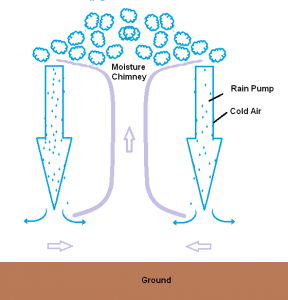
A bottom driven tornado only requires an updraft to establish a conduit for buoyant air to escape from ground level into upper atmospheric levels. In the case of the lowly dust devil, the entire process occurs in feet and usually lasts seconds to minutes. In the case of the isolated vertical weather tornado, humid ground level air is transported to the cloud layer initiating a vertical weather tornado[i]. One workable theory is the concept that lightning strikes provide an initial vertical conduit for an air chimney. The lightening strike’s advantage is a single upward air movement all the way from the cloud to the ground.
The lightning strike concept assumes that there is enough internal cloud movement to create an electrical charge capable of reaching the ground, which is certainly possible on summer afternoons as the sun is concentrated on the peaks of clouds accentuating their vertical movement.
Plant growth on a hillside provides an ideal vertical conduit for initiating vertical updrafts. The hillside angle reduces stagnation effects effectively creating a ground level channel for airflow.
A single tree in a field can initiate vertical updrafts because the open area below the leaves offers little resistance to vertical flow and leaves provide a vertical source of highly buoyant air. As mentioned above and prove below, the updraft will immediately move toward a less buoyant source of ground air.
[i] Author’s note –
Intuitively, it would seem that the cloud layer has plenty of moisture, but temperature differential is key. There is a very significant temperature difference in the first few hundred feet of atmosphere. High humidity air at ground level can retain much more water than the same air at 1,000 ft because the lapse rate (change in temperature for change in altitude) reduces the air. The lapse rate for the first 36,000 ft is about 6.5 degrees per 1,000 feet. However, for the first 1,000 feet that value is larger. Personal helicopter experience indicates a lapse rate more like 20 degrees F for the first 1,000 feet in tropical areas. The area above the first 2 – 200 feet begins a stagnation region where there is little air mixing.
Next The isolated vertical weather tornado
Back to About Tornadoes
